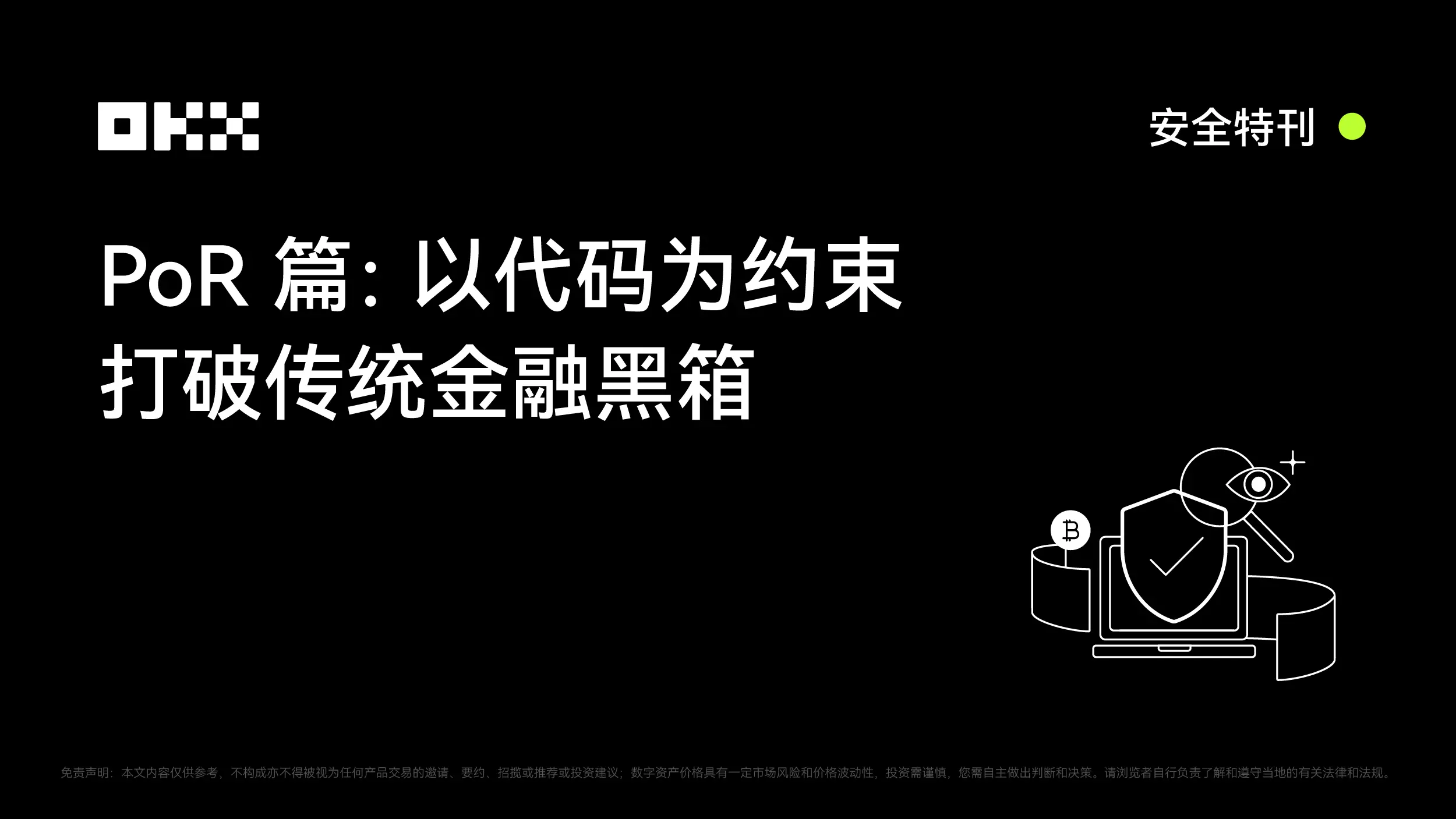Dialogue OKX DEX: How to Find the Optimal Solution for Cross-Chain Trading?
Author: 0xFat
When cross-chain narratives first became popular, the industry generally believed that exchanges were the most suitable players to engage in this space, as they had rich experience on the asset side and could closely meet user demands. Unfortunately, at that time, no exchange truly entered the arena, as from a profitability perspective, such a business with low returns on heavy investment was not cost-effective. However, with the improvement of mainstream public chain infrastructures like Ethereum and Bitcoin, decentralized applications have continued to grow in the multi-chain ecosystem, and the real demand from investors for cross-chain trading has gradually emerged, marking the right time for developers to invest in building.
An industry insider commented: "Opportunities come with timing; one wallet, all chains unified, this wave belongs to OKX."
Timing is one aspect, but pragmatism is another.
According to official disclosures, OKX's Web3 ecosystem infrastructure—OKX DEX has seen rapid growth in user and trading data this year, with daily trading users surpassing 10,000, daily transactions exceeding 20,000, and daily trading volume approaching $20 million. This article will delve into the current state of the cross-chain trading sector, exploring how OKX DEX achieved such results and what their product development journey looks like, attempting to reveal the pragmatic side of the OKX product research and development team.
About OKX DEX: OKX DEX is an important infrastructure of the OKX Web3 ecosystem, composed of the aggregator SWAP and the cross-chain bridge. Similar products tend to focus more on aggregator trading and asset cross-chain functionality, but currently, OKX DEX is the only product in the market that balances both.
1. Discussing the Current State of the Sector: Improving Trading Efficiency is a Shared Consensus
1. From your understanding, what is the current state of the cross-chain aggregator sector?
OKX DEX: Early DEXs primarily focused on on-chain asset trading issues, and the flourishing decentralized protocols gave rise to trading aggregators. As the number of public chains and asset types increased, the fragmentation of on-chain asset liquidity intensified. Therefore, integrating various long-tail asset liquidity to improve trading efficiency became crucial, and the existence of cross-chain aggregators is aimed at solving this problem.
Currently, cross-chain aggregators mainly consist of cross-chain bridges and SWAPs. Due to the complexity and high cost of developing such products, there are not many teams working on them. Among them, Bungee and Li.fi mainly focus on cross-chain bridge development, having integrated a larger number of bridges and users, while 1inch and Matcha primarily focus on developing trading aggregator SWAPs with relatively stable pricing algorithms, each with its strengths. OKX DEX, however, is the only product in the market that balances both.
As OKX DEX, we have developed our own pricing algorithm system that can aggregate multiple liquidity protocols to provide users with the optimal path and quotes. In terms of cross-chain bridges, our on-chain integration speed is very fast, and we have integrated a large number of bridges and chains, almost supporting all cryptocurrencies for cross-chain transactions as well as custom cross-chain bridges. At the same time, we will promptly follow market hot chains to provide users with convenient access to various ecosystems. Of course, we have also established a backend service team that can directly receive user feedback, maximizing the efficiency of addressing user concerns. In summary, the current cross-chain aggregator sector is striving to improve user trading efficiency, and all R&D work is almost based on this premise, and OKX DEX is no exception.
2. At this stage, the differences between various products are not obvious. As a relatively latecomer, do you believe there is a moat for cross-chain DEXs?
OKX DEX: As decentralized products, DEXs themselves do not have a moat, but there is a moat in the cross-chain aggregator field.
First, algorithmic capability is the core competency of aggregator DEXs. Currently, no product in the market has open-sourced its aggregation pricing algorithm; they only open-source contracts. Our task is to help users find the best path and quotes among numerous DEXs, which is essentially a mathematical problem involving linear programming, knapsack strategies, and more. Additionally, we need to consider algorithmic differences between different protocols, algorithm translation, and algorithm efficiency. From a pricing perspective, the algorithm must consider price differences between different pools and gas fees to comprehensively find the optimal path for users. In summary, it is about finding the optimal solution among a series of variables, which poses a significant challenge for some Web3 startups, hence the relatively low number of products in the aggregator space.
Secondly, there is the issue of algorithm implementation, which involves a very important infrastructure—on-chain data parsing capability. To find the optimal path among numerous DEXs, we must first obtain accurate on-chain data and process it quickly. On-chain data is vast; we not only need to address accuracy issues but also speed issues. OKX has a team of over a hundred people handling these aspects, making our infrastructure very robust. Once we obtain this data, we can process and refine it to enable functional development, making our algorithms meaningful. For users, they will find our pricing efficiency to be very fast and accurate, precisely because we have strong on-chain data parsing capabilities to ensure the highest efficiency and accuracy in quotes.
Finally, from the perspective of cross-chain bridges, we believe the biggest moat lies in how to integrate numerous diverse bridges, which include differences in algorithmic logic and technical implementation. The bridges in the market cover various types such as liquidity pool models and shadow asset models, and each type has several different subtypes. For example, the liquidity pool model includes 1:1 cross-chain and AMM cross-chain, and each bridge has slight differences in rates and calculation rules. Therefore, some cross-chain bridge aggregators can only connect via API, resulting in slow pricing efficiency. However, OKX DEX's algorithm team consists of dozens of people; we have researched and integrated mainstream cross-chain bridges in the market, building dozens of templates based on their characteristics, allowing us to automatically discover and connect to similar bridges. Currently, we have integrated over 20 cross-chain bridges, including third-party and official bridges.
In summary, algorithmic capability and cross-chain bridge integration capability are essential infrastructures for building a super cross-chain aggregator and form the foundation of a moat. If there is anything more, it would be micro-innovations on top of these infrastructures, such as intent trading features.
3. The concept of intent trading is very popular, but few can clearly articulate its value. As developers, what conveniences can this feature bring to users from your perspective?
OKX DEX: Intent trading is a product designed based on user trading needs and intentions. In this design structure of DEX, users only need to express their intentions and then obtain results, leaving the intermediate processes to the protocol. This concept may sound complex, but the underlying logic is essentially to attract on-chain market makers, scientists, and MEV arbitrageurs through a unique auction mechanism, allowing them to participate in quote competition, resulting in better quotes and balancing the interests of makers, takers, and LPs, thereby enhancing user experience.
Intent trading DEXs provide a product experience that is closer to traditional internet products. Users do not need to understand the complex on-chain trading algorithm logic; the product only serves the user's final trading intent. This design model can reduce operational thresholds, lower trading costs, enhance asset security, and strengthen interaction capabilities, facilitating the large-scale adoption of Web3 and providing users with a smoother and more convenient trading experience, even personalized trading scenarios.
Currently, many teams in the market are already working on such initiatives, including the established DEX Uniswap launching Uniswap X, leading aggregator product 1inch introducing fusion mode, and the popular cowswap this year, all adopting intent trading logic. Our OKX DEX team will collaborate with Uniswap X to develop the intent trading feature.
2. Discussing Product Development: Strong Parsing Power and Automation Systems are Key to Success
4. As an important part of the OKX Web3 ecosystem layout, OKX DEX can be seen as a significant achievement under the concept of "one wallet, all chains unified." How do you think a truly user-adapted super cross-chain aggregator can be built?
OKX DEX: Our fundamental principle is to provide users with fast and secure product services based on market hotspots, such as integrating all accessible bridges. Taking the Bitcoin ecosystem as an example, we have previously integrated the SWFT cross-chain bridge and are currently integrating the ThorSwap cross-chain bridge. We will also pay attention to trends in other popular narratives to integrate more bridges, such as the Wormhole cross-chain bridge in the Solana ecosystem.
On the other hand, we will continue to invest in algorithmic and parsing capabilities, which are the unseen backbone that meets user needs, ensuring optimal trading prices and secure asset interactions. The OKX all-in-one product design philosophy will also provide users with the most convenient, quick, and unified trading experience.
5. Many investors say that cross-chain aggregators have the highest construction costs among existing DEX categories. Why is OKX willing to invest heavily in this area?
OKX DEX: Swap and Bridge have always been very important infrastructures in the Web3 field, fulfilling users' most basic trading demands. This is not a short-term sector; whether the inscription sector is hot, or the DeFi sector, or NFT, GameFi, SocialFi, etc., will generate a large amount of trading demand. In other words, asset trading, the "Fi" part, is what endows various Web3 sectors with the core vitality to thrive. Therefore, the most commonly used tools for users in trading are Bridge and Swap.
From the perspective of Bridge, users need to transfer assets between various chains to participate in these dazzling hot projects. From the Swap perspective, there may be multiple trading opportunities on the same chain, and users need to exchange assets to capture more opportunities. However, there is currently no product in the market that simultaneously supports multi-chain Bridge and Swap, which increases the participation threshold and interaction costs for users.
To provide users with a good product experience and save them the hassle of jumping back and forth between different chains and protocols, we decided to invest our efforts into this endeavor, hoping to provide users with the most comprehensive and best cross-chain aggregated trading services through practical actions. We firmly believe that serving users is our top priority and the original intention behind our willingness to invest.
6. What has been the development journey of OKX DEX? What challenges did you encounter during the development period?
OKX DEX: We launched as a cross-chain trading aggregator in January 2022, and by around December 2022, we completed the first phase of our pricing algorithm development. We utilized the X-routing algorithm to automatically discover pools with good on-chain liquidity and automate the integration, achieving automated detection of algorithm accuracy and providing users with optimal pricing results based on gas fee considerations. At the beginning of this year, the team started developing an on-chain automated detection system, creating an automated detection system across multiple dimensions such as protocol discovery, algorithm translation, trading monitoring, and quote comparison to safeguard OKX DEX users' trading.
The biggest challenge we faced when establishing OKX DEX was the self-developed pricing algorithm mentioned earlier, as there was no open-source aggregator algorithm available in the market, which required us to develop our own algorithm. Moreover, this algorithm had to be superior to others, so we conducted extensive research on algorithm selection. The mainstream algorithms in the market include binary methods, linear programming, knapsack strategies, etc. We took the strengths of each algorithm to establish a completely self-developed pricing algorithm system.
Another challenge came from the diverse protocol algorithms in the market. Protocol algorithms integrate different DEX pricing methods into our own pricing algorithm, and then we combine different DEX algorithm quotes for pricing calculations to find the optimal solution. This stage involves splitting comparisons and routing comparisons, and the premise for achieving optimal pricing is accurate translation of each protocol's algorithms. Initially, we used manual methods to translate protocol algorithms, but later found that the biggest issues with manual translation were potential errors and low efficiency. Therefore, we developed a complete automated system to automatically discover on-chain protocols, automate translation, automate integration, and automatically monitor algorithm accuracy, significantly enhancing our efficiency. Currently, OKX DEX has integrated over 400 DEXs and more than 20 cross-chain bridges, with an annual trading volume of $1,000 million across all chains.
7. What is the strategic position of OKX DEX within the OKX Web3 ecosystem? Can you share future development plans?
OKX DEX: DEX has always been positioned as an important infrastructure within the OKX Web3 ecosystem. Our goal is to make inter-chain trading as simple as CEX, striving to lower user operational thresholds. As everyone knows, OKX's values are rooted in long-termism, consistently driven by innovation for our development. Our achievements in building the Bitcoin ecosystem are the best proof of this. At the same time, we believe that opportunities are reserved for those who are prepared; the team is responsible for building the infrastructure, and when the time is right, it will naturally be ignited.
Regarding future plans, we can outline three phases:
The first phase is to leverage the existing automated system and strong parsing capabilities to continue improving trading efficiency and lowering user usage thresholds. We will continuously integrate more chains and protocols while optimizing algorithm logic and user experience to provide Web3 users with the best one-stop trading service.
The second phase is to seize the intent trading model, introducing on-chain market makers, scientists, and MEV arbitrageurs into the pricing competition mechanism, allowing those skilled to do what they excel at, improving the order efficiency of makers and takers, and exploring the future trading forms of DEX from a product perspective, providing innovative features for unique trading scenarios.
The third phase is to contribute the accumulated technical experience to the industry, providing system building services (WaaS) for peers, and jointly building a prosperous on-chain ecosystem. We will package infrastructures like wallets and DEXs along with upper-layer interfaces into easy-to-use and programmable SDKs and API interfaces, offering a one-stop SDK and API integration solution, effectively lowering the technical barriers of blockchain fundamentals, allowing developers to focus more efficiently on application layer innovations.
3. Discussing the Evolution of the Landscape: Aspiring to Become the TOP 1 in Users' Minds
8. Currently, the DEX sector is highly competitive, with increasing homogeneity. Even leading players like Uniswap are seeking change. How do you think the landscape of DEXs will evolve in the future?
OKX DEX: Currently, 1inch has a relatively high market share, but as the infrastructure construction of chains becomes more robust, intent trading will be increasingly valued. The implementation of intent trading features results in better pricing without gas fees and high transaction success rates; even if a transaction fails, there is no gas fee incurred. In the future, OKX will simultaneously implement algorithmic pricing and intent trading pricing, aiming to provide users with the most advanced trading models and the smoothest trading experiences.
From a broader perspective, the DEX industry will continue to innovate. We see novel protocols and unique algorithms emerging continuously, which is a sign of the industry's rapid growth. Returning to the sector itself, future competition will become increasingly fierce, but this is good news for users, as it is very conducive to the birth of quality products. For the OKX DEX team, this is also beneficial; team members can learn and grow through competition, accumulating experience and becoming stronger. We believe that as long as we continue to uphold the user-first philosophy, accumulate foundational technology, and embrace industry innovations, we will ultimately produce the products that best meet user needs. OKX DEX is confident in becoming the TOP 1 product in users' minds.









